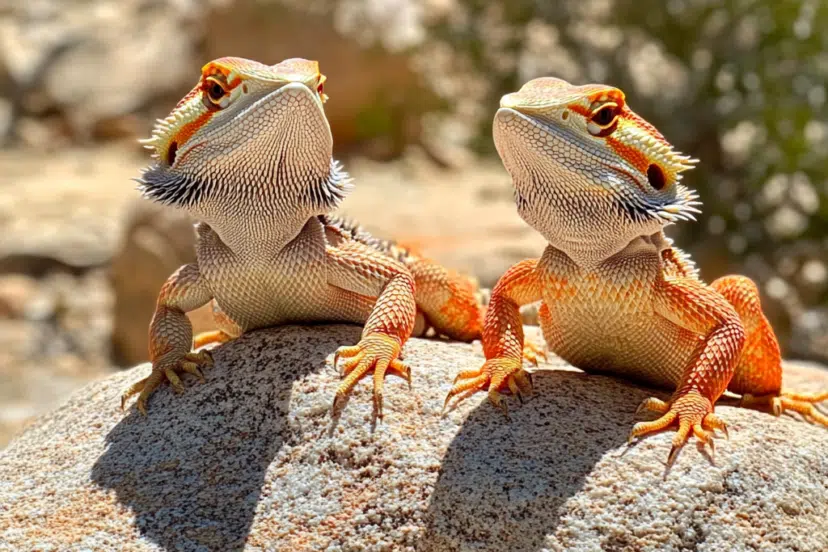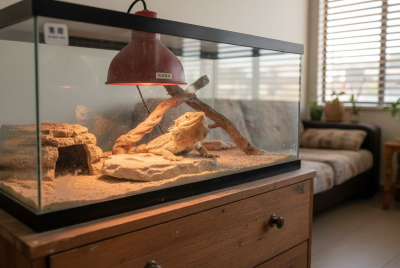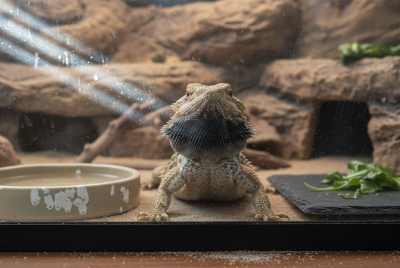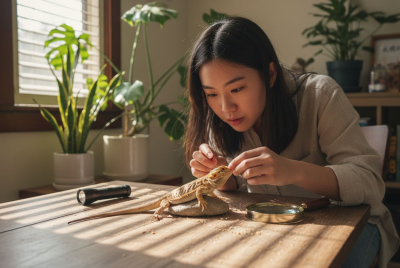Bearded Dragons: Male vs. Female – A Complete Guide
If you’re a bearded dragon enthusiast, or thinking about getting one, you’ve likely wondered, “Should I choose a male or female?” Both male and female bearded dragons make excellent pets, but they have distinct differences in behavior, appearance, and care needs. In this article, I’ll guide you through understanding these differences so you can make an informed decision on which gender might be best for you.
Understanding Male and Female Bearded Dragons
Whether you’re a first-time owner or an experienced bearded dragon enthusiast, knowing the differences between male and female dragons is essential for providing the best care. The two genders are similar in many ways, but they differ in behavior, size, and certain health considerations. In this guide, I’ll help you distinguish between male and female bearded dragons and share tips on how to care for each.
How to Tell the Difference Between Male and Female Dragons
Determining whether a bearded dragon is male or female can sometimes be tricky, especially when they’re young. However, there are several ways to tell the difference, including examining their physical features and behavior.
Visual Cues: Head and Body Shape
Males often have broader, larger heads compared to females. Additionally, males tend to have more muscular bodies, while females have slightly narrower bodies. These differences become more pronounced as the dragon reaches adulthood.
Examining Femoral Pores and Hemipenal Bulges
The most reliable way to determine a bearded dragon’s sex is by looking at their femoral pores (small pores located on the underside of their thighs) and the presence of hemipenal bulges (two small bulges located at the base of the tail). Males generally have larger, more visible femoral pores, while females’ pores are smaller and less pronounced. Males also have two hemipenal bulges, while females have one smoother bump.
Behavioral Differences Between Male and Female Dragons
Male and female bearded dragons can exhibit different behaviors, especially during the breeding season. Understanding these behaviors can help you identify the sex and anticipate how your dragon might act in certain situations.
Mating and Dominance Behaviors
Male bearded dragons are more likely to display territorial or dominance behaviors, especially during mating season. They may exhibit head bobbing, a rapid up-and-down motion, to show dominance or attract a mate. In contrast, females might be more submissive but can also display territorial behaviors, especially when defending their space.
Head Bobbing and Arm Waving
Head bobbing is a common behavior in male bearded dragons, typically used to assert dominance. Females, on the other hand, may exhibit arm waving, a slower, more passive gesture that signals submission. Watching for these behaviors can give you insight into your dragon’s gender, especially during breeding season.
Physical Growth and Size Differences
When it comes to size, male and female bearded dragons have noticeable differences, although these aren’t always immediately obvious.
Are Males Typically Bigger Than Females?
Yes, male bearded dragons tend to grow slightly larger than females. Males can reach lengths of up to 24 inches, while females usually max out at around 20 inches. This size difference is more noticeable in mature dragons and can influence the space requirements for their habitat.
Tail Thickness and Length Differences
Males generally have thicker tails, especially near the base, where their hemipenal bulges are located. Females, in contrast, tend to have thinner, more streamlined tails.
Temperament and Personality Traits of Male and Female Dragons
Choosing between a male and female bearded dragon often comes down to temperament. While individual dragons have unique personalities, some general trends can help you decide which gender might suit you better.
Are Males More Aggressive?
Males are often perceived as more aggressive, especially during mating season. However, this isn’t always the case. While males may display more dominant behaviors, they can still be gentle and friendly, especially with consistent handling and socialization. Females tend to be calmer overall but can also become defensive if they feel threatened.
Which Gender Is Better for Beginners?
If you’re new to owning bearded dragons, either gender can make a great pet. However, females may be slightly easier for beginners because they tend to be more laid-back and less territorial than males, especially outside of breeding season.
Health Considerations for Male and Female Bearded Dragons
Male and female bearded dragons face different health challenges. Knowing these can help you care for your dragon’s specific needs.
Male-Specific Health Concerns
Males can experience issues with impacted hemipenes if they don’t properly retract after mating behaviors. They’re also more likely to develop clogged femoral pores, which can cause discomfort and infection if not cleaned regularly.
Female-Specific Health Concerns
Female dragons can develop issues related to egg-laying, even if they’ve never been with a male. This is called gravid, and females may lay unfertilized eggs. If the eggs become stuck, it can lead to egg binding or dystocia, which is a serious condition requiring veterinary attention.
Egg Laying and Dystocia
If you own a female dragon, it’s important to provide a laying box when she shows signs of being gravid. Dystocia, or egg-binding, is a serious health concern that can occur when a female cannot pass her eggs. To prevent this, ensure your dragon is healthy and provide the right environment for egg-laying.
Breeding Bearded Dragons: What to Know About Each Gender
If you plan on breeding bearded dragons, it’s essential to understand the differences in care for males and females during this process.
Breeding Preparation and Season
Breeding typically occurs during the spring. Males will exhibit increased dominance behaviors like head bobbing and darkening of the beard, while females may show signs of being gravid. It’s important to separate males and females after mating to prevent stress or aggressive behaviors.
Special Care for Female Dragons After Laying Eggs
After a female lays eggs, whether fertilized or unfertilized, she will need extra care, including proper nutrition, hydration, and a comfortable environment. A calcium-rich diet is crucial to help her recover and prevent metabolic bone disease.
Male vs. Female Bearded Dragon as a Pet?
When choosing between a male or female bearded dragon, consider factors like space, behavior, and your ability to meet their specific care needs.
Factors to Consider for Your Home Environment
If space is limited, a female dragon may be a better choice since they tend to stay slightly smaller. On the other hand, if you want a larger, more interactive pet, a male might be a better fit.
Personal Preferences and Care Requirements
Consider your personal preferences in terms of handling and temperament. If you’re looking for a more docile dragon, a female might be better suited for you. However, a male could provide more interesting interactions if you enjoy observing territorial and mating behaviors.
Common Myths About Male and Female Bearded Dragons
There are several myths surrounding male and female bearded dragons. Let’s debunk a few:
Myth: Males Are Always More Aggressive
While males can show dominance, they aren’t always more aggressive. With proper handling and socialization, both male and female dragons can be equally calm and friendly.
Myth: Females Are Easier to Care For
While some believe that females are easier to care for, this isn’t always the case. Female bearded dragons can face health issues related to egg-laying, even without a male. This means they may require special care, such as providing a laying box and ensuring a calcium-rich diet to recover from the stress of laying eggs.
Conclusion: Understanding the Unique Needs of Both Genders
Both male and female bearded dragons make wonderful pets, but they do have different needs, behaviors, and health concerns. By understanding the unique characteristics of each gender, you can make an informed decision and provide the best care possible for your bearded dragon. Whether you choose a male or female, you’ll be rewarded with a fascinating and engaging reptile companion.
FAQs
- How can I tell if my bearded dragon is male or female?
Look for differences in head size, femoral pores, and the presence of hemipenal bulges. Males typically have larger pores and visible bulges near the tail base. - Do male or female bearded dragons grow larger?
Males tend to grow slightly larger than females, reaching up to 24 inches in length, while females usually grow to about 20 inches. - Can female bearded dragons lay eggs without a male?
Yes, females can lay unfertilized eggs, which requires extra care. Providing a laying box and ensuring proper nutrition is essential. - Which gender is more aggressive: male or female?
Males can be more territorial, especially during breeding season, but both genders can be equally calm with proper handling and care. - Should I get a male or female bearded dragon as a beginner?
Both genders are suitable for beginners. However, females may be slightly easier to handle as they tend to be less territorial outside the breeding season.
By knowing the differences and understanding their care needs, you can enjoy the companionship of a bearded dragon, whether you choose a male or female. Each dragon has its unique charm, and with proper care, they’ll thrive and become a cherished part of your life.





